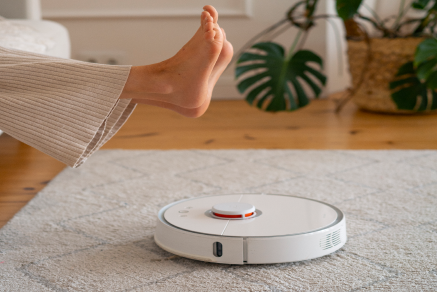Webinars


PROJECT
Robot Vacuum
As the adoption of robotic vacuum cleaners continues to grow, concerns around the security and privacy implications of these connected devices have become increasingly prevalent. Recognizing the need to proactively address these issues, a leading manufacturer of robot vacuums engaged our team of security experts to conduct a comprehensive assessment of their product’s security posture. The scope included its hardware, firmware, associated mobile applications, and communication channels.
Our assessment leveraged a combination of advanced security assessment methodologies, industry-leading tools, and specialized scripts to meticulously probe the robotic cleaner for vulnerabilities. This included comprehensive tests on firmware, mobile app security, communication protocols, and local data storage. From the outset, it was clear that the manufacturer had made significant strides in incorporating security features, such as encrypted data transmission and user authentication. However, our in-depth analysis revealed several vulnerabilities that, if left unaddressed, could expose users to potential risks.
One significant issue identified was insecure communication channels, despite initial encryption implementations. Through detailed network analysis, our experts demonstrated that certain sensitive data transmissions were vulnerable to interception, potentially exposing private user information, including device locations and cleaning schedules.
Additionally, our analysis of the device’s firmware update mechanism revealed weaknesses, notably the lack of robust digital signatures. This vulnerability could allow attackers to inject malicious firmware, thereby compromising device integrity and enabling attackers to gain unauthorized access to user networks and data.
Our examination of the robot vacuum’s mobile applications identified critical issues, such as the ability to exploit the application’s functionalities to access internal test and unreleased features. Attackers could manipulate these vulnerabilities, potentially affecting device control and monitoring capabilities and enabling unauthorized surveillance.
In response to our findings, we recommended comprehensive remediation measures including:
- Enhancing application-level security measures, specifically reinforcing authentication and authorization to prevent unauthorized access to sensitive app features.
- Strengthening communication protocols to safeguard against interception and manipulation.
- Strengthening local cryptographic implementation to ensure that the information handled or stored by the robot is up to industry standards.
- Implementing secure firmware updates utilizing robust digital signatures to validate authenticity and integrity.
- Anti-automation protection mechanisms in mobile apps, rigorous sandboxing, and strengthened privacy controls.
- Training the development and operations teams on advanced mobile security practices to foster an organizational culture of security awareness and preparedness.
In conclusion, the manufacturer of the robotic vacuum cleaner had made significant strides in addressing the most common security and privacy vulnerabilities associated with these connected devices before engaging with us. However, the in-depth assessment conducted by our team of security experts revealed that even with these robust security measures in place, there are still critical flaws that could be exploited by malicious actors. The vulnerabilities discovered in the remote control and monitoring capabilities, firmware update process, and local data storage underscore the importance of adopting a multi-layered security approach and continuously evaluating the evolving threat landscape. The findings of this assessment highlight the value of diverse perspectives and skill sets in identifying and addressing security challenges. This emphasizes the importance of engaging external security experts to provide an independent and comprehensive assessment of a product’s security posture. This proactive approach helps manufacturers maintain consumer trust by continuously protecting users against evolving threats inherent in connected home technologies.


PROJECT
Motorcycle Ignition Control System (ICS) Reverse Engineering
CUSTOMER CONCERNS
The motorcycle’s ignition control system (ICS) governs the spark timing to ignite the engine’s fuel-air mixture. The client needed to understand if the system could be reverse-engineered to tweak the performance of the motorcycle, such as increasing horsepower by adjusting spark timing or altering the rev limits.
THE MISSION: WHY WE HACKED IT
The ignition control system on this motorcycle, a Suzuki Katana, was being investigated for potential performance tuning. The system was embedded within a sealed box and controlled the timing of the ignition sparks via a microcontroller. The client wanted to reverse engineer the system to modify the engine’s performance. The goal was to learn more about the ICS and determine if it could be reprogrammed to boost performance without compromising reliability.
We approached the reverse engineering process by:
- Hardware Deconstruction: Attempted to physically access and probe the circuit board within the sealed ignition control system to understand how it operated.
- Microcontroller Identification: Identified the microcontroller governing the system, despite challenges caused by the protective sealing, and searched for debugging or reprogramming interfaces.
- Sealant Protection Mechanism: The system was heavily sealed with materials designed to deter reverse engineering, which led to some damage when trying to access the board.
- No Debug Interface: Despite thorough testing of potential interfaces, there was no straightforward method to reprogram the microcontroller or extract the firmware.
- Limited Firmware Accessibility: The microcontroller utilized mask ROM, meaning the firmware was hardcoded and could not be extracted without advanced techniques like decapping.
- Pivot the approach to Black Box Testing: By simulating the inputs and measuring the outputs (e.g., camshaft position and throttle), the client successfully inferred the ignition timing algorithms.
- Build a Custom Simulator: The client created a custom microcontroller system to mimic the ICS behavior and explore performance tuning possibilities.


PROJECT
Sprinkler Controller with BLE Support and Mobile Apps
CUSTOMER CONCERNS
With the addition of Bluetooth Low Energy (BLE) support, the client’s updated controllers were designed to allow users to control the system remotely via mobile applications. The client needed to ensure that this new connectivity didn’t introduce vulnerabilities, which could potentially expose customer devices to unauthorized access.
THE MISSION: WHY WE HACKED IT
The client was integrating BLE into their next-generation IoT sprinkler controller. BLE is a common technology in IoT devices, but it’s also a frequent target for hackers due to its security misconfigurations. The client needed assurance that the new connectivity didn’t open up paths for attackers to compromise devices, manipulate sprinkler settings, or gain unauthorized access to user networks. Our goal was to pinpoint any security flaws early, ensuring that customers’ homes and gardens weren’t at risk from cyber threats.
We tackled the security review using two methodologies:
- OWASP Top 10 for Mobile Applications: Assessed the mobile app for vulnerabilities like insecure data storage, insufficient transport layer protection, and improper authentication.
- IoT Testing for BLE Configuration: Examined how BLE was implemented and configured to ensure there were no common misconfigurations like lack of authentication or unencrypted data transmission.
- Design Flaws in the BLE Pairing Process: Weak pairing mechanisms made it easier for potential attackers to eavesdrop or interfere.
- Vulnerabilities in Mobile App Data Handling: Sensitive data was being stored without adequate encryption, making it possible for an attacker with device access to extract and misuse it.
- Exposed Device Commands: Several BLE commands used to control the sprinkler settings were not properly secured, leaving room for unauthorized manipulation.
By remediating these issues, the client was able to:
- Secure the BLE pairing process, ensuring that only legitimate users could control the device.
- Implement secure storage and transmission methods for sensitive information within the mobile apps.
- Lock down device commands, reducing the likelihood of malicious tampering.
As a result, the client’s BLE-supported sprinkler controllers were not only more secure, but they also provided peace of mind to end-users, who could trust that their smart systems were robust against potential cyber threats. This proactive security testing allowed the client to go to market with confidence, turning a potential risk into a competitive advantage.


PROJECT
Medical Device Security
CUSTOMER CONCERNS
Automated medical devices that connect to hospital networks and cloud services present unique security challenges. In this particular case, the target was an embedded system that allowed hospital personnel to authenticate to workstations by means of Bluetooth Low Energy that performed active presence detection and user tracking. The client was concerned that potential vulnerabilities could allow unauthorized device or workstation control, data tampering, or the exposure of sensitive patient information. The objective was to assess the device’s resilience to cyberattacks and ensure compliance with industry regulations.
THE MISSION: WHY WE HACKED IT
Security Innovation was tasked with evaluating the medical device’s software, embedded hardware, network connections, and data management practices. The mission was to identify security gaps that could be exploited to compromise patient safety or disrupt medical procedures.
Our security assessment involved:
- Network Vulnerability Testing: Assessed connections to hospital and cloud networks for weaknesses that could allow unauthorized access.
- Data Integrity Analysis: Evaluated how patient data was stored and transmitted, focusing on encryption and tampering prevention.
- Hardware Attack Simulation: Ubertooth One and NRF51 were used to sniff the BLE traffic between the target components of the customer hardware and application. Gatttool was used to discover, read, and write to available BLE characteristics.
- Device Control Simulation: Simulated potential attack scenarios to test if remote control of the device was possible.
- Insufficient Data Encryption: Found that certain data transmissions were inadequately protected, posing a risk of interception and tampering.
- Unrestricted BLE Characteristics: Insecure Bluetooth Low Energy (BLE) settings left the proximity tracking vulnerable to manipulation, enabling unauthorized monitoring of user activity and interference with expected operations
- Flawed Authentication: Intercomponent interactions and protocols were insecure, potentially enabling a jamming attack that would circumvent system authentication.
- Piggybacking Attacks: MITM on the Bluetooth connection allowed capturing the UUIDs, MAC and other values to add them to another application without consent.
- Unauthorized Access Paths: Identified pathways that could allow attackers to gain control over the device or access patient data.
- Regulatory Gaps: Highlighted areas where security measures did not align with industry regulations, impacting compliance.
- Enhance Data Encryption: Implement comprehensive encryption standards to safeguard patient data.
- Secure Network Access: Close unauthorized access paths and strengthen authentication measures.
- Achieve Compliance: Align device security protocols with industry standards to meet regulatory requirements.